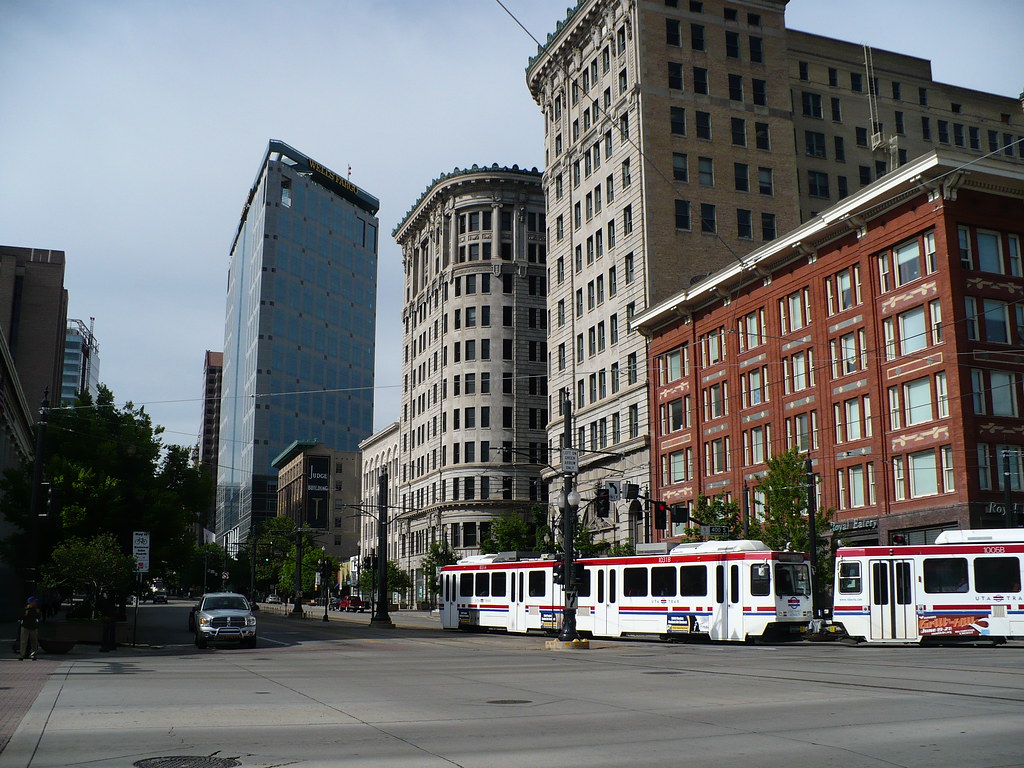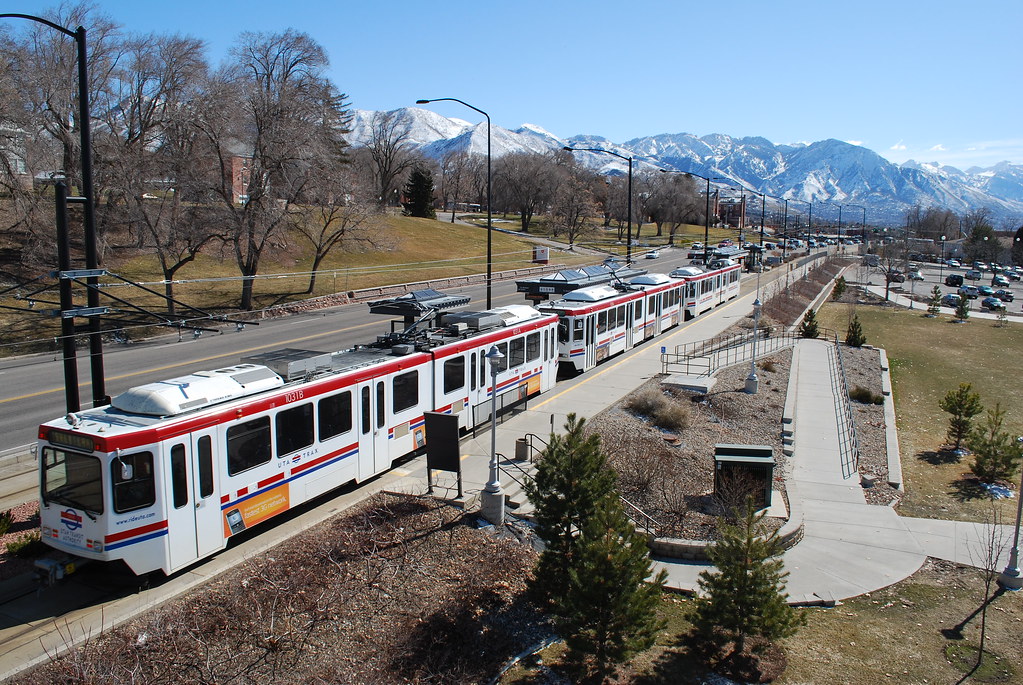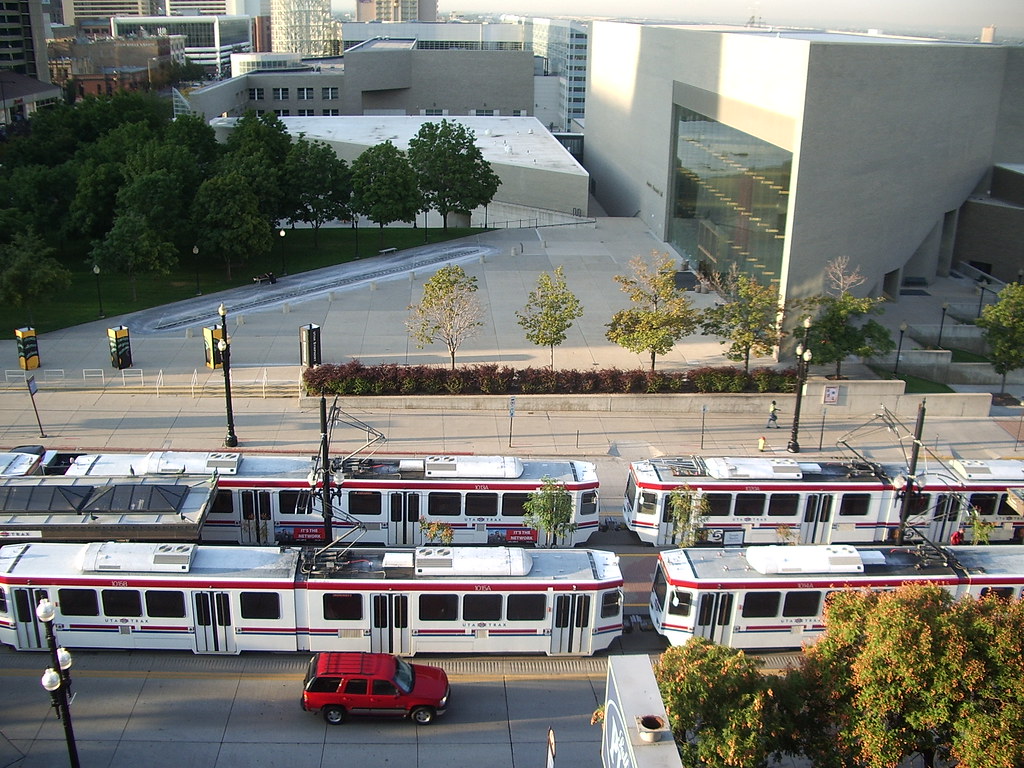Rail still a hit in Utah
 by davidwilson1949
by davidwilson1949
 by Transit Nerds
TRAX was once a gamble, but now it's solidly part of the Wasatch Front's future.
By Maria Villasenor
by Transit Nerds
TRAX was once a gamble, but now it's solidly part of the Wasatch Front's future.
By Maria Villasenor
The Salt Lake Tribune
 Work begins on the Trax extension to Salt Lake International Airport on the dedicated corridor
Work begins on the Trax extension to Salt Lake International Airport on the dedicated corridor
from 2400 West to the airporton Wednesday, September 2,2009 photo:
Paul Fraughton/ The Salt Lake Tribune
The night before the first TRAX train began shuttling people between downtown Salt Lake City and Sandy was
an agonizing one for Utah Transit Authority officials.
"We were worried, just worried," said UTA Assistant General Manager Mike Allegra. "I couldn't sleep because you
just didn't know if anybody would use it."
Allegra and UTA general manager John Inglish knew the Salt Lake Valley needed light rail, but numerous protests
and fervent opposition to TRAX persisted right up to the Dec. 4, 1999, opening.
That day, though, thousands of people crowded the then-Delta Center station to ride the trains along the 17-mile
route -- so many that the inaugural kinks included stranded people, trains stopped in the middle of tracks and
hundreds turned away.
 It will be the 10-year anniversary of TRAX on Dec. 4th. TRAX operator Robbie Robinson a
It will be the 10-year anniversary of TRAX on Dec. 4th. TRAX operator Robbie Robinson a
31 year veteran employee of UTA and a TRAX driver for 10 years pulls into the City Center station wary of the
the three pedestrains running in front of the train. He has to be ready for anything. He said that he wishes he
trusted himself as much as pedestrians trust him to stop the train. (Al Hartmann / The Salt Lake Tribune 11/20/2009 )
It was a hit, Inglish said.
"That was so heartwarming, to see the community embrace this new alternative, this change," Allegra said.
In the decade since, that single north-south line has expanded to include lines to the University of Utah and a
downtown inter-modal hub, which links TRAX to the commuter rail, FrontRunner.
Also, more Utahns have hopped aboard the trains: About 500,000 people rode TRAX each month when it first
started; monthly ridership now exceeds a million.
Construction is under way to expand the network to 10 times its original reach.
That boom in construction and support for TRAX makes Inglish and Allegra chuckle when they stand at the 1300
South station and remember the day they broke ground at the stop and protesters shouted at them and held signs
claiming that "Light rail kills children."
Backbone of mass transit » UTA officials already have a broad vision for what the upcoming decades will hold. Train
tracks, either light or commuter rail, will be the backbone of a network that will include streetcars, buses and
bus-rapid transit, as well as pedestrian and bike ways across the Wasatch Front, Inglish said. Eventually, he wants
90 percent of the urban population within one mile of public transportation.
 It will be the 10-year anniversary of TRAX on Dec. 4th. UTA Asst. General Manager Mike Allegra,
It will be the 10-year anniversary of TRAX on Dec. 4th. UTA Asst. General Manager Mike Allegra,
left, takes a ride on a TRAX light rail train with UTA General Manager John Inglish in downtown Salt Lake City. They
were the big architects behind TRAX and ultimately spreading rail across the Wasatch Front area.
(Al Hartmann / The Salt Lake Tribune 11/20/2009 )
"You won't need a car, but you'll still want to have one," Inglish said, adding the best transit solution is a mixture
of both.
For the past seven years, Joan Showalter's daily commute has been far simpler. The 56-year-old legal secretary
drives to the 10000 South stop in Sandy and rides TRAX to the Gallivan Center station.
The TRAX ride takes about 30 minutes, which is a bit longer than driving and was something Showalter had to
get
used to. Though the Sandy-to-Salt Lake City highway drive might be 13 minutes most of the time, rush hour is
another matter.
"It's a lot less stressful and I feel like I get something done during the day," she said while holding a book in her
seat at the front of a full car.
Showalter has seen public transportation avidly used in other areas, but she admits, "I never thought it would
work here because people are too attached to their cars ... it's been a pleasant surprise to see how it's worked."
That "love affair" Americans have with their cars is often touted, but Inglish said it's an idea that's overblown. Who,
he asked, can really be enamored with sitting in traffic and simmering with road rage?
Trains are convenient, frequent, reliable and speedy. "You have all of the elements that Americans are looking
for in a transportation system," Inglish said, adding light rail runs on schedule 98 percent of the time compared
with buses, which might top 80 percent.
The 'Phoenix project'» In the late 1970s, light-rail projects started appearing in various North American cities.
After traveling and studying those systems, Inglish thought trains could work in Utah, too. Plans began to grow
in 1984 for a Salt Lake County north-south line, but hit a bump in 1992 when voters rejected a sales tax hike
that would have funded construction on the light-rail corridor, as well as expanding the bus network and Interstate
15 improvements.
"We didn't have any funding, but we still had the same problem," said Allegra, about the growing congestion in
the county.
So, UTA continued pushing for light rail.
Though the up-front building costs are far greater with light rail than with buses, since the road is already in place,
trains are "the more economically viable option" in the long run, about 30 years, Inglish said.
Once networks have been built, each train car can haul 200 people, and most TRAX trips include links of four
cars.
Buses usually seat fewer than 75 people. Per trip, Inglish said, it costs $1.25 to move each person on light rail,
compared to between $3 and $4 on a bus.
With too little support from Salt Lakers, UTA turned to the federal government. A couple of months after Salt Lake
City was selected in 1995 to host the 2002 Winter Olympics, the Federal Transit Administration agreed to fund 80
percent of the capital costs on the $312 million project.
In 1997 construction began, and the following year, the four-lane Main Street was shut down to construct platforms
and tracks for the trains, as well as separate utility work.
"It was harrowing," said Catherine Weller, an owner of Sam Weller's Bookstore on Main Street, who saw other nearby
stores close down during that period. The problem was there was poor planning, she said, and Main Street hasn't
bounced back since then, though there have been other factors outside of TRAX affecting that.
"No matter how terrible it was," Weller said of construction, "we continue to be supporters of TRAX and mass
transit initiatives."
It's a support that has become more widespread, say UTA officials. Voters approved a quarter-cent sales tax
increase in 2000 and again in 2007 to accelerate TRAX construction.
"The public is stepping up," Inglish said. "They're saying, 'We want it now.' "
The early skepticism about TRAX has evolved into conservative business groups and local governments clamoring
to have rail running through their communities, he said.
"It's now a part of life, people expect it."
But rail doubts have lingered.
"I don't think it's done any great favors to transit down here," said Salt Lake City resident Stephen Pace, who led
the anti-rail group Utahns for Responsible Public Spending. He said UTA should have focused instead on buses that
have the same right-of-way preference over cars as trains, but are more flexible and require a less massive
investment.
Pace rails against the "so-called" elected officials who champion fiscally conservative values but are "just as deep
in the federal trough as anybody else" to fund TRAX extensions into their communities.
But that popular support is testament to TRAX's success, say regional planners.
--
Getting there » There are TRAX extensions under construction that would run through Salt Lake City's west side,
West Valley City, Midvale, West Jordan and South Jordan. One is being proposed into Draper.
Also, TRAX trains have linked up to commuter rail. FrontRunner trains travel north to Pleasant View in Weber County,
and work has already started on a southern route that would transport people at freeway speeds to Provo.
"The suburbs are trying to serve residents wanting to get access," to mass transit, said planning director Gabe
Epperson of the sustainability group Envision Utah. "A lot of communities are changing city plans around existing
or future TRAX stops. They've changed their zoning and created transit-oriented development zones around their
stops."
Those TOD zones were touted more than a decade ago when TRAX was first proposed.
"It has started a little slower than we'd like," said UTA's Allegra. The plan was to have UTA and cities partner with
builders to create developments that mixed housing and businesses and supplied people with quick and close access
to public transit.
The Gateway in Salt Lake City is an example of such a project, but most cities are still far from seeing those
large-scale projects built.
"The economy is terrible, but it's perfect for the planning" aspect of these developments, said Allegra, noting
he has seen smaller housing and condominium buildings dot the TRAX corridor.
In Midvale, the Center Street housing development was meant to be a small-scale version of a TOD, but a
bank owns the unfinished project, said Mayor JoAnn Seghini.
But even in that city, a WinCo grocery store already opened at Bingham Junction, a multi-use project on a
203-acre site that was formerly contaminated.
"We pushed very hard to get [the Mid-Jordan TRAX line] so that it would go across what was a former Superfund
site," Seghini said, adding that light rail is a boon to economic development.
And more of those TOD projects will be needed as Utah doubles in size by 2040, said planner Epperson.
Keeping populations concentrated will mean far cheaper utility costs, he said, since building longer lines is more
expensive. Reducing the amount of developed land has a huge impact in helping conserve water and reducing
air pollution, Epperson added.
"That wouldn't be possible without the evolving and expanding rail system," he said.
Don't leave buses behind » But with the additions and expansions made in rail service, Main Street business owner
Weller said she hopes bus service isn't sacrificed for car-less or late-night workers or in working-class neighborhoods.
"I think that TRAX has succeeded as a tool for commuters," Weller said, adding she applauds UTA for that, though
many of her workers could use more frequent trains later in the day.
Commuters are what UTA should be addressing with light rail, said planner Epperson.
"We don't have a traffic problem as a region," he said, "our problem is with commuting."
Buses aren't as desirable for that kind of travel because they have to compete with road traffic, Epperson said.
Midvale resident Juan Carlos Ranjel uses buses or light-rail as his sole means of getting around. TRAX works well
for when the 50 year old works as a supervisor at a downtown restaurant or janitor at the University of Utah,
he said -- "It's the best. It's comfortable."
But when he wants to go to other parts of the valley, Ranjel takes buses and complains they run too infrequently
and that one trip to Layton took double the time getting back.
Changes are made to bus service, but UTA is legally mandated not to disproportionately affect low-income people
through changes, Inglish said.
Though routes have been altered and criticism has followed, those are often improvements that take people time to
get used to, he said.
In fact, Inglish added, light rail has helped increase the use of public transportation across UTA.
In the early '90s, about 25 percent of people had used mass transit in the past year, he said of a survey that was
repeated more recently since TRAX was available. Those subsequent numbers show around 75 percent of people
have used UTA.
Light rail has drastically shifted how many people look at public transportation, Inglish said. "It's hard to believe it's
10 years old."
mariav@sltrib.com
The history and future of TRAX
From a controversial beginning, light rail has grown in ridership and expanded in reach. As TRAX celebrates
its 10th anniversary Friday, many communities are clamoring for TRAX
extensions and FrontRunner is providing the inter-city link up and down the Wasatch Front.
 by Edgar Zuniga Jr.
by Edgar Zuniga Jr.
 TraxCity
TraxCity
 by Kevin Shieh
by Kevin Shieh
 Jo's Pictures
Jo's Pictures
.
..



